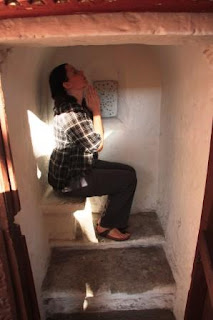

Whilst we were waiting until we could go to our hotel we decided check out Casa del Moral. This colourful eighteenth century colonial mansion owes its name to the ancient blackberry tree that grows in its paved main patio. The house is filled with colonial and republican furniture as well as some interesting antique maps (Brazil is depicted with cannibals feasting on legs) that I wouldn’t mind getting my hands on. I have decided for my next humble abode I would like a Spanish villa with a central courtyard – do you think you can get them in Melbourne? In Jon’s sleep deprived state he gave a rather large tip to our guide. I could hear her laughing with delight as she walked away. I did not find it amusing.
Once 10am finally came around we went back to the hotel only to find it was overbooked. We ended up having to find another bed – was not impressed.
After an all too brief nap we set off for the Monastario de Santa Catalina (Saint Kathleen Monastery). This convent is practically a citadel within the city. It was founded in 1580 by the widow Maria de Guzmán who became its first inmate (is that a correct term for a secluded nun?) and prioress. It was predominantly for the second daughter of the wealthiest Spanish families in town as it cost a mere fortune for the privilege of being locked away for the rest of your natural life. At one stage 500 women were living there, this included around 300 servants. I imagine there would have been a lot of bitchy confessions made.
 Forgive me father for I have sinned... lots!
Forgive me father for I have sinned... lots!The buildings inside are amazing – all brightly coloured (originally they were white) and reminiscent of the architecture of the Greek islands. I am sure they are of Spanish influence but as I haven’t been anywhere in Spain except Barcelona (doesn’t look anything like Barcelona) so I can’t vouch for this. There are many narrow streets with paved roads and everywhere you look is a photo opportunity.

A view of the snow capped volcanoes in the distance.



 Upon entering, the women were novices first for four years, living in solitary confinement for all but two hours a day (seems more like hell to me). They were allowed to bring with them 21 objects when they first arrived. Once you included the essentials such as a chamber pot and bed linen this didn’t leave much. Lucky for them, family could visit for one hour a month (behind heavy screens) and bring gifts such as gold plated tea sets. In fact, once you passed the novice stage, life was pretty hedonistic on the inside with the nuns living it up in their own houses and having up to four servants each. That is, if you ignore the no guys rule and that they were only allowed to bath and cut their hair seven times a year (it must have stunk, no wonder they wanted to live separately).
Upon entering, the women were novices first for four years, living in solitary confinement for all but two hours a day (seems more like hell to me). They were allowed to bring with them 21 objects when they first arrived. Once you included the essentials such as a chamber pot and bed linen this didn’t leave much. Lucky for them, family could visit for one hour a month (behind heavy screens) and bring gifts such as gold plated tea sets. In fact, once you passed the novice stage, life was pretty hedonistic on the inside with the nuns living it up in their own houses and having up to four servants each. That is, if you ignore the no guys rule and that they were only allowed to bath and cut their hair seven times a year (it must have stunk, no wonder they wanted to live separately).  Inside a nun´s humble abode.
Inside a nun´s humble abode.Towards the end of the 1700s a visiting bishop thought that a series of reforms were in order and issued a decree for communal life to be introduced as well as only one servant allowed per nun. Well, the nuns responded with a law suit – they won. However, eventually a strict Dominican nun arrived to straighten things out and the women in the convent ended up having to learn how to cook and do their own washing. Today there are 30 sisters (aged between 18 and 90) living there. Their days start at 5.00am and they don’t have servants.
After our tour I discovered the antiques area of town. Now there are lots of things I have seen that I want and can’t have (big sigh).



No comments:
Post a Comment